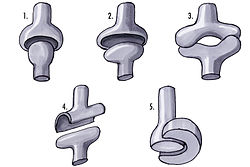| Pivot joint | |
|---|---|
 1: Ball and socket joint; 2: Condyloid joint (Ellipsoid); 3: Saddle joint; 4 Hinge joint; 5: Pivot joint; | |
| Details | |
| Identifiers | |
| Latin | articulatio trochoidea |
| TA98 | A03.0.00.045 |
| TA2 | 1557 |
| FMA | 75294 |
| Anatomical terminology | |
In animal anatomy, a pivot joint (trochoid joint, rotary joint or lateral ginglymus) is a type of synovial joint whose movement axis is parallel to the long axis of the proximal bone, which typically has a convex articular surface.
According to one classification system, a pivot joint like the other synovial joint —the hinge joint has one degree of freedom.[1] Note that the degrees of freedom of a joint is not the same as a joint's range of motion.
Movements[edit]
Pivot joints allow for rotation, which can be external (for example when rotating an arm outward), or internal (as in rotating an arm inward). When rotating the forearm, these movements are typically called pronation and supination. In the standard anatomical position, the forearms are supinated, which means that the palms are facing forward, and the thumbs are pointing away from the body. In contrast, a forearm in pronation would have the palm facing backward and the thumb would be closer to the body, pointing medially.
Examples[edit]
Examples of a pivot joint include:
In contrast, spherical joints (or ball and socket joints) such as the hip joint permit rotation and all other directional movement, while pivot joints only permit rotation.
References[edit]
![]() This article incorporates text in the public domain from page 285 of the 20th edition of Gray's Anatomy (1918)
This article incorporates text in the public domain from page 285 of the 20th edition of Gray's Anatomy (1918)
Well, that’s interesting to know that Psilotum nudum are known as whisk ferns. Psilotum nudum is the commoner species of the two. While the P. flaccidum is a rare species and is found in the tropical islands. Both the species are usually epiphytic in habit and grow upon tree ferns. These species may also be terrestrial and grow in humus or in the crevices of the rocks.
View the detailed Guide of Psilotum nudum: Detailed Study Of Psilotum Nudum (Whisk Fern), Classification, Anatomy, Reproduction